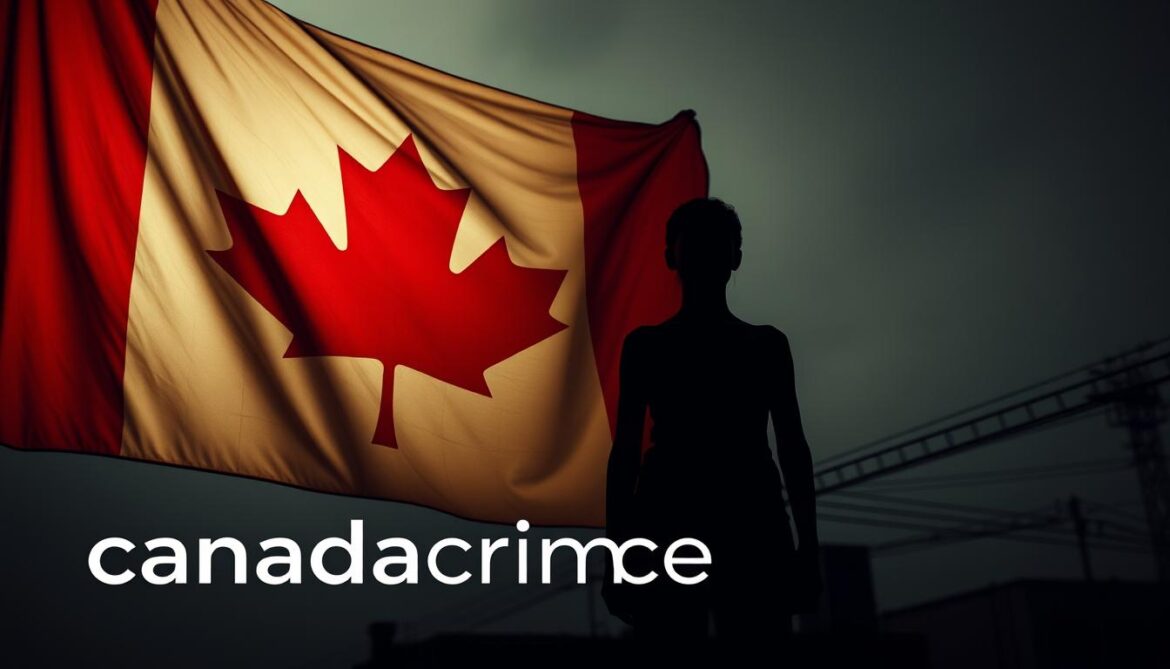Canadian police reported nearly 1,700 human trafficking cases from 2009-2018. Experts believe this is only a small portion of actual incidents. Real people are trapped in dangerous situations within your community.
This hidden crime affects thousands across Canada. It often operates in plain sight. Victims may appear to work in domestic, massage, or restaurant jobs.
Modern slavery takes many forms in Canadian society. Victims are recruited and controlled by traffickers. They are forced into labor or sexual services against their will.
This guide will help you spot warning signs of human trafficking. You’ll learn about laws that fight this crime. We’ll also show you how to help vulnerable individuals.
By educating yourself, you can make a difference. Your knowledge could potentially save lives in your community.
The Reality of Human Trafficking in Canada
Human trafficking in Canada affects thousands of lives each year. Many Canadians don’t know it happens in their communities. This crime occurs in cities and rural areas alike.
Recognizing human trafficking is crucial for fighting this human rights violation. It impacts people across the country in various ways.
Definition and Key Concepts
Human trafficking involves controlling a person’s movements to exploit them. It has three parts: action, means, and purpose. The action is recruiting or transporting people.
The means involve force or deception. The purpose is exploitation. Canadian law defines exploitation as forcing victims into sex work or labor.
Traffickers often target vulnerable people. They create situations where victims feel they have no choice but to obey.
The Scope of the Problem Nationwide
Human trafficking happens all over Canada. Some areas are at higher risk than others. Big cities like Toronto, Montreal, and Vancouver are known hotspots.
However, trafficking also occurs in smaller cities and rural areas. Official numbers likely show only a small part of actual cases.
Many victims stay hidden due to fear or shame. Language barriers and distrust of authorities also play a role. This makes it hard to know the true extent of trafficking.
Distinguishing Between Trafficking and Smuggling
Human smuggling and trafficking are different crimes. Smuggling involves helping people cross borders illegally for money. It ends once they reach their destination.
Trafficking focuses on ongoing exploitation. It doesn’t require crossing borders and often happens within Canada. Smuggling starts with consent, while trafficking involves force or trickery.
The main difference is the purpose. Smuggling is about movement, while trafficking is about exploitation. Understanding this helps in identifying and responding to each crime correctly.
The Legal Framework: Canada’s Anti-Trafficking Laws
Canada fights human trafficking with a wide-ranging legal system. This system covers federal, provincial, and international levels. It gives authorities tools to prosecute criminals and protect victims.
Criminal Code Provisions (Section 279.01-279.04)
Canada’s Criminal Code has specific provisions targeting human trafficking. These laws make it illegal to recruit, transport, or control people for exploitation. Penalties are tough, with life sentences for severe cases.
The Code also tackles related crimes. These include profiting from trafficking and destroying identity documents. Both actions help traffickers exploit victims.

Immigration and Refugee Protection Act
Section 118 of the IRPA deals with cross-border human trafficking. It bans organizing entry into Canada through force or trickery. Offenders face harsh punishments.
- Imprisonment for up to life
- Fines reaching $1 million
- Deportation for non-citizens
The IRPA works with the Criminal Code. Together, they cover domestic and international trafficking cases. They focus on child trafficking across borders.
Provincial Legislation and Initiatives
Some provinces have their own anti-trafficking laws. Ontario’s act lets victims get restraining orders and sue traffickers. Manitoba’s law offers similar help.
Alberta protects minors from sexual exploitation. Their act focuses on keeping children safe from trafficking.
International Agreements and Canada’s Commitments
Canada joined the UN’s Palermo Protocol in 2002. This agreement requires Canada to follow the “3P” approach:
| Approach | Canadian Implementation | Key Elements |
|---|---|---|
| Prevention | Public awareness campaigns and education | Border monitoring, training for officials, community outreach |
| Protection | Temporary Resident Permits for victims | Healthcare access, social services, witness protection |
| Prosecution | Dedicated enforcement units | Specialized training for law enforcement, international cooperation |
Canada also joins global efforts to stop trafficking. These partnerships help share information and fight cross-border crime networks. They strengthen Canada’s work to end human trafficking.
Statistics and Trends of Human Trafficking in Canada
Human trafficking in Canada is a serious issue. Official stats only show a small part of the problem. Many cases go unreported due to various challenges.
From 2013 to 2023, over 4,500 trafficking incidents were reported to police. This number likely represents only a fraction of actual cases.
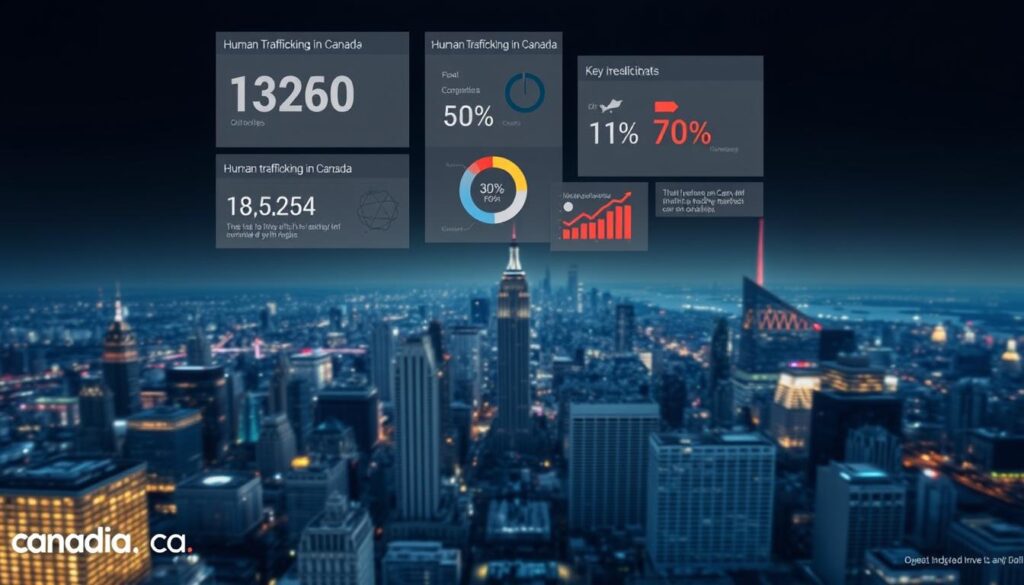
Current Data and Reporting Challenges
Victims often can’t report due to fear, language barriers, or distrust. Trauma and lack of awareness about resources also prevent reporting. These factors create a “dark figure” of unreported trafficking cases.
High-Risk Areas and Trafficking Routes
86% of reported incidents occur in census metropolitan areas. Major cities are key hubs for trafficking operations. No region of Canada is immune to this problem.
Trafficking networks operate along major transportation corridors. These include the Highway 401 in Ontario and the Trans-Canada Highway. Cross-border routes near major ports of entry are also common.
- The Highway 401 corridor in Ontario
- The Trans-Canada Highway
- Cross-border routes near major ports of entry
Traffickers often move victims across provinces. This isolates victims from support and complicates law enforcement efforts.
Demographics of Victims and Traffickers
Human trafficking affects various groups. However, certain patterns emerge in who is most vulnerable and who commits these crimes.
Age and Gender Patterns
Gender disparities are clear in trafficking cases. 93% of victims are women and girls. 82% of accused traffickers are men.
Young people face higher risks. 23% of victims are 17 or younger. 42% are between 18-24 years old. 23% fall in the 25-34 age range.
- 93% of victims in police-reported cases are women and girls
- 82% of persons accused of trafficking are men
- 23% of victims are aged 17 and younger
- 42% fall between 18-24 years old
- 23% are between 25-34 years old
Domestic vs. International Trafficking
Most trafficking in Canada involves domestic victims, not international ones. This fact surprises many people.
“The public often imagines human trafficking as involving foreign nationals brought into Canada, but our data consistently shows that the majority of identified victims are Canadian citizens trafficked within our borders.”
The victim-trafficker relationship is troubling. 91% of victims know their trafficker. 34% are exploited by current or former partners.
- 91% of victims are trafficked by someone they know
- 34% are exploited by current or former intimate partners
Domestic sex trafficking is most common. However, international labor trafficking remains a concern. It often affects temporary foreign workers in agriculture, construction, and domestic work.
| Characteristic | Domestic Trafficking | International Trafficking | Primary Exploitation Type |
|---|---|---|---|
| Typical Victims | Canadian citizens | Foreign nationals | Varies by trafficking type |
| Common Control Methods | Emotional manipulation, addiction | Document confiscation, debt bondage | Threats, isolation, violence |
| Primary Sectors | Sex industry | Agriculture, construction, domestic work | Sex industry, labor sectors |
| Reporting Barriers | Fear, trauma, addiction | Language, immigration status, isolation | Fear of authorities, shame |
These stats and trends are key to fighting human trafficking. They help create better prevention strategies and support services for victims in Canada.
Recognizing the Warning Signs of Human Trafficking
Spotting human trafficking signs can save lives in Canada. By learning these indicators, you can help solve this growing problem. These warning signs fall into several categories.
Physical Indicators
Physical signs often reveal human trafficking. Look for unexplained injuries, bruises, or burns that suggest abuse. Victims may appear malnourished, exhausted, or overworked.
Poor hygiene and inappropriate clothing can indicate trafficking. Untreated medical issues may also be present. These signs reflect traffickers’ control over victims’ basic needs.
Behavioral and Psychological Signs
Behavioral changes can reveal trafficking situations. Victims may show extreme fear or anxiety in everyday settings. They might act submissive or defer to others when speaking.
Some rarely answer calls or vanish for long periods. Many avoid eye contact or seem coached when talking. Victims may defend their abusers due to trauma bonds.

Situational Red Flags
Certain living and working conditions suggest trafficking. Watch for people living with employers or working excessive hours. Constant monitoring of movements is another red flag.
Be alert if someone seems unfamiliar with their neighborhood. Frequent address changes and lack of personal items are concerning. Many victims report having their identification documents taken away.
Digital and Online Indicators
Sex trafficking often leaves online traces. Look for suspicious ads with coded language or multiple people under one number. Coerced images or signs of abuse are serious warnings.
Traffickers use social media for recruitment and control. Watch for sudden changes in online activity or mentions of quick money. Awareness of these digital clues can help identify hidden victims.
Vulnerable Populations: Who Is at Risk
Certain groups in Canada face higher risks of human trafficking. These risks stem from systemic factors and personal circumstances. Understanding these vulnerabilities is key to creating effective prevention and support systems.
Indigenous Women and Girls
Indigenous women and girls are at high risk of human trafficking in Canada. Historical trauma and ongoing discrimination create conditions that traffickers exploit. Many trafficking networks target Indigenous communities, operating between reserves and urban centers.
There’s a growing awareness of the link between human trafficking and missing Indigenous women. Intergenerational trauma and limited access to services in remote areas increase vulnerability.
Youth in Care and Runaways
Up to 60% of trafficking victims have histories in the child welfare system. Youth in foster care often lack stable homes and permanent family connections. Traffickers target these vulnerabilities by offering false promises of love and security.
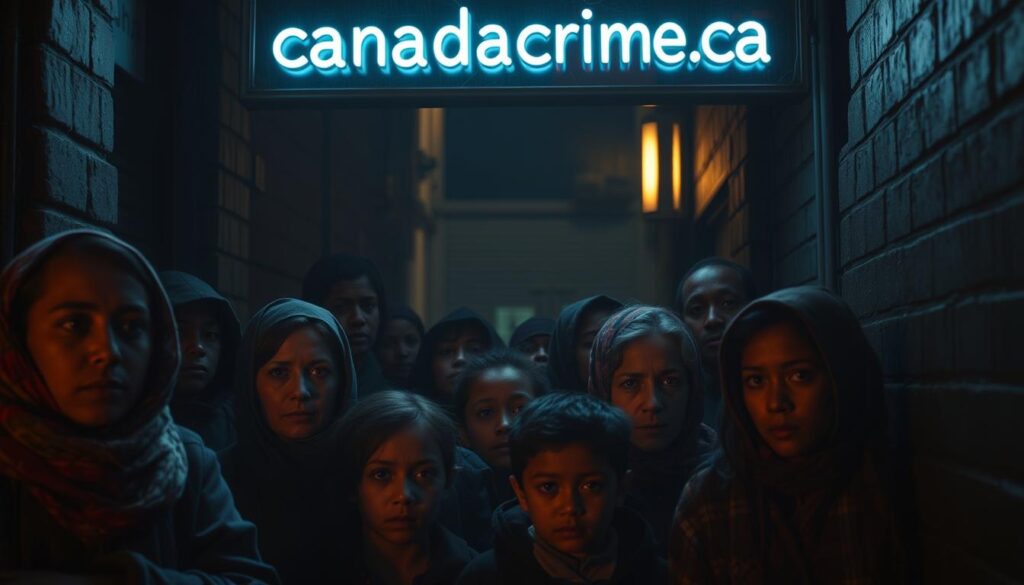
Migrants and Temporary Foreign Workers
Migrants and temporary workers face exploitation risks due to several factors. These include language barriers, unfamiliarity with Canadian laws, and isolation. Industries like agriculture and construction can become sites of forced labor when oversight is limited.
Many victims stay silent due to fear of deportation or retaliation. Their precarious immigration status adds to their vulnerability.
LGBTQ2S+ Individuals
LGBTQ2S+ individuals, especially youth, face high trafficking risks when rejected by family or homeless. Traffickers exploit their need for acceptance and economic survival. Without support and specialized services, they may become trapped in exploitative situations.
Persons with Disabilities
People with disabilities may be targeted due to increased dependency on caregivers. Traffickers may control access to medication or assistive devices as coercion tactics. Communication barriers often make reporting abuse difficult.
Cognitive disabilities can be exploited through manipulation and false promises. Recognizing these risk factors helps communities develop targeted prevention strategies. It also ensures support services address each vulnerable population’s unique needs.
Forms of Human Trafficking Prevalent in Canada
Human trafficking takes many forms in Canada. Recognizing these helps fight the crime effectively. Each type targets different vulnerabilities, creating unique challenges for detection and intervention.
Sex Trafficking
Sex trafficking is the most common form in Canada. It mainly affects women and girls, but men and boys can be victims too. Traffickers use manipulation, coercion, and violence to exploit people for sex.
Commercial Sexual Exploitation
This crime happens in various places across Canada. High-risk spots include escort services, hotels, massage parlors, and nightclubs. Traffickers often create trauma bonds with victims, making escape mentally tough.
According to research, big cities are hubs for this exploitation. Victims are often moved between cities along set routes.
Online Sexual Exploitation
The internet has changed how sex trafficking works. Traffickers now use social media, dating apps, and websites to find victims. This online shift makes catching criminals harder as they quickly adapt to changes.

Labor Trafficking and Forced Labor
Labor trafficking happens in many industries in Canada. It’s common in farming, construction, food processing, and manufacturing. Victims often work in dangerous conditions for little or no pay.
“Labor trafficking victims are often hidden in plain sight, working in legitimate businesses but under conditions of extreme exploitation and control.”
Temporary foreign workers are at high risk. They face language barriers and may not know Canadian laws. They also depend on employers for their immigration status.
Domestic Servitude
Domestic servitude is hard to spot. Victims, usually foreign nationals, are exploited in private homes as housekeepers or caregivers. The private nature of these jobs makes detection difficult.
Victims often face isolation and long work hours. They may live in poor conditions and suffer mental abuse. Many have their IDs taken and receive little or no pay.
Forced Marriage and Debt Bondage
In Canada, forced marriages often involve cultural pressures. Young women from immigrant communities may be forced into exploitative marriages. Debt bondage forces victims to work off impossible debts.
Organ Trafficking
Organ trafficking is rare in Canada but still concerning. It exploits vulnerable people for their organs. Canada’s good healthcare system makes this less common here.
This crime usually targets very vulnerable groups, like those in extreme poverty. It involves complex networks that illegally harvest and transplant organs.
Reporting Human Trafficking: What You Should Know
Knowing how to report human trafficking can save lives. Your report could help someone escape exploitation and start healing. Let’s explore the proper channels for reporting suspicious activities or potential victims.
Emergency and Non-Emergency Reporting Options
Call 911 if someone is in immediate danger. This includes witnessing violence or learning about imminent harm.
For non-emergency situations, contact your local police’s non-emergency line. You can also call Crime Stoppers at 1-800-222-TIPS (8477) to report anonymously.
Many Canadian cities have specialized anti-trafficking units. These units understand trafficking dynamics and provide appropriate support.
The Canadian Human Trafficking Hotline
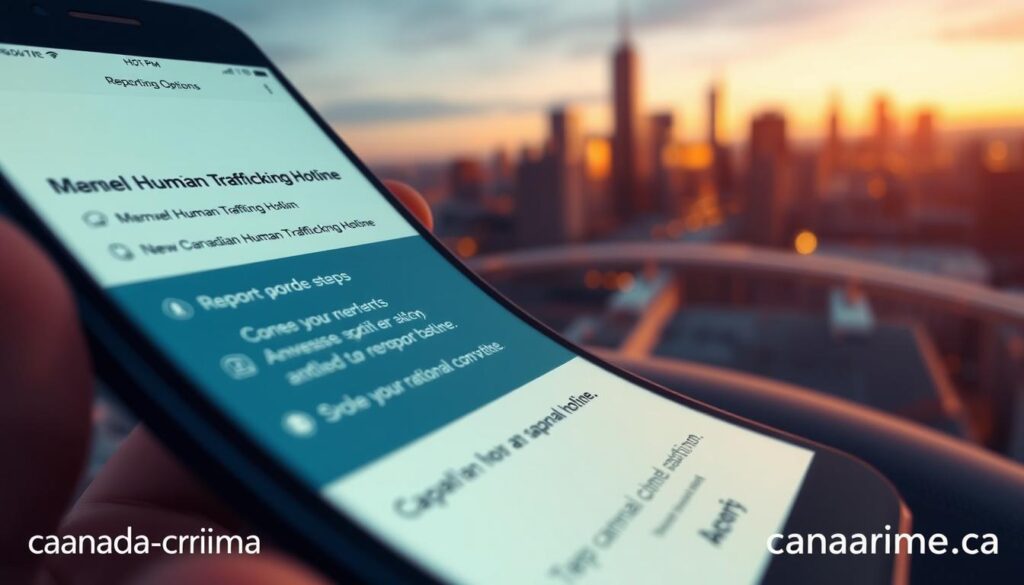
The Canadian Human Trafficking Hotline (1-833-900-1010) operates 24/7. It offers confidential support in over 200 languages.
Trained specialists provide crisis intervention and safety planning. They also connect callers to local support services.
You can report suspected trafficking anonymously. Your information helps track trafficking patterns across Canada.
Law Enforcement Response
After a report, law enforcement begins a careful investigation. They collect evidence and work to ensure victim safety.
Officers use trauma-informed approaches and work with victim services. Building trafficking cases often depends on victim cooperation.
Confidentiality and Safety Considerations
Your identity can be protected through anonymous reporting options. This is crucial if you have safety concerns.
Never attempt to intervene personally in suspected trafficking situations. Traffickers often monitor victims closely and may retaliate.
Be mindful that victims may face increased risk if traffickers suspect a report. Law enforcement approaches these situations cautiously to minimize potential harm.
Support Services for Survivors in Canada
Canada offers many resources to help survivors heal and reintegrate after human trafficking. These services focus on immediate safety and long-term recovery needs. They form a crucial safety net for those escaping human trafficking situations.
Government Programs and Temporary Resident Permits
The Canadian government provides Temporary Resident Permits (TRPs) for trafficking survivors. These permits offer legal status for up to 180 days, with possible extensions. You don’t need to testify against traffickers to qualify.
TRPs grant access to health programs, work permits, and social assistance. This gives you time to consider options without legal pressures. Provincial victim funds can also provide financial support for recovery expenses.
Non-Governmental Organizations and Shelters
Specialized shelters across Canada offer trafficking-specific programs and safe housing. Covenant House helps youth survivors, while the Native Women’s Association supports Indigenous women.
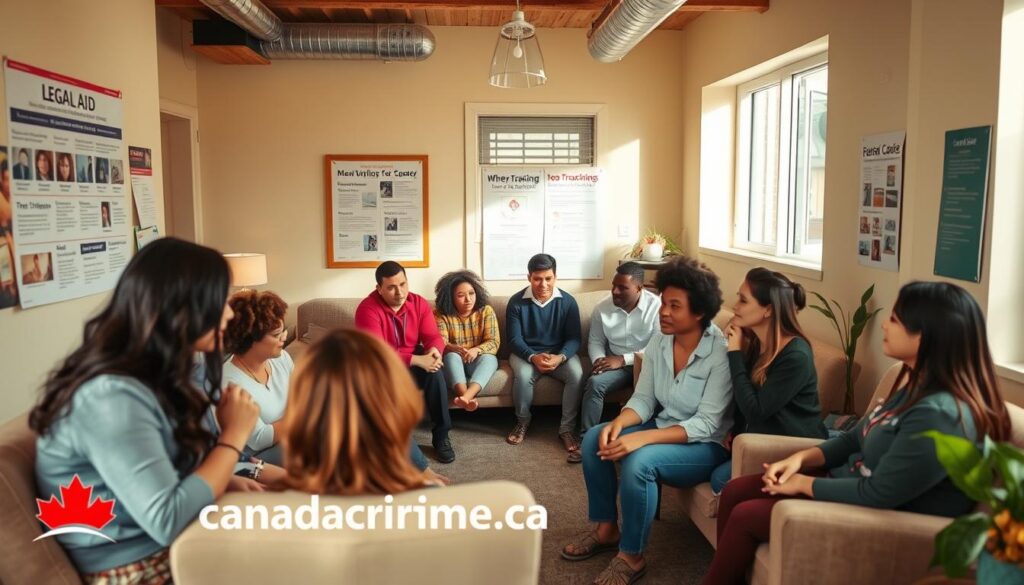
These organizations provide crisis intervention, case management, and peer support programs. Many shelters understand survivors’ safety concerns and maintain confidential locations with enhanced security.
Healthcare and Mental Health Resources
Trauma-informed healthcare services address both physical and psychological impacts of trafficking. You can access specialized counseling that understands the complex trauma experienced by survivors.
Many programs offer addiction support, recognizing its connection to trafficking experiences. Culturally appropriate mental health services ensure respect for your background throughout healing.
Legal Support and Immigration Assistance
Pro bono legal services help with challenges like criminal record expungement and civil remedies. Victim advocacy programs guide you through the justice system if you choose to participate.
Specialized immigration consultants assist with permanent residency, refugee claims, or other immigration matters. These experts understand trafficking survivors’ unique circumstances and can advocate effectively.
Long-term Recovery and Reintegration Services
Education programs, job training, and life skills development form the foundation of long-term recovery. Survivors of debt bondage often need specialized financial literacy support to rebuild economic stability.
Case managers coordinate various services, creating personalized recovery plans. These plans address your specific needs and goals for building an independent life.
| Support Type | Immediate Services | Medium-Term Support | Long-Term Resources |
|---|---|---|---|
| Housing | Emergency shelters | Transitional housing | Housing subsidies |
| Health | Crisis medical care | Trauma counseling | Ongoing therapy |
| Legal | Immediate protection | Immigration assistance | Civil remedies |
| Financial | Emergency assistance | Job training | Education programs |
Conclusion: Taking Action Against Human Trafficking
Fighting human trafficking in Canada needs everyone’s help. The UN Palermo Protocol suggests focusing on preventing harm and protecting victims. You can apply these ideas in your everyday life.
Share what you know about trafficking signs with others. This spreads awareness and makes communities safer. Support organizations that help survivors through donations or volunteering.
Your shopping choices can make a difference. Check if companies use ethical labor practices. Buying responsibly disrupts the profit cycle that fuels trafficking in Canada.
Use your voice to create change. Ask elected officials for stronger anti-trafficking laws and better victim support. If you work in certain fields, get trained to spot trafficking.
Human trafficking grows when people stay silent. Report suspicious activity to the Canadian Human Trafficking Hotline at 1-833-900-1010. Your actions, big or small, help build a safer Canada for everyone.
FAQ
What is human trafficking according to Canadian law?
How is human trafficking different from human smuggling?
What are the penalties for human trafficking in Canada?
FAQ
What is human trafficking according to Canadian law?
Canadian law defines human trafficking as recruiting, transporting, or controlling a person for exploitation. The Criminal Code criminalizes these actions when force, coercion, or deception are used. This definition covers both domestic and international trafficking.
How is human trafficking different from human smuggling?
Trafficking focuses on exploiting victims for profit, while smuggling involves illegal border crossings for payment. Trafficking can occur within borders, but smuggling always crosses them. Trafficking victims are controlled through force or fraud, unlike smuggling, which starts with consent.
What are the penalties for human trafficking in Canada?
The Criminal Code imposes severe penalties for human trafficking offenses. Trafficking adults can lead to 14 years in prison. Trafficking minors can result in life imprisonment.
Related offenses also carry significant penalties. The Immigration and Refugee Protection Act punishes cross-border trafficking with fines up to
FAQ
What is human trafficking according to Canadian law?
Canadian law defines human trafficking as recruiting, transporting, or controlling a person for exploitation. The Criminal Code criminalizes these actions when force, coercion, or deception are used. This definition covers both domestic and international trafficking.
How is human trafficking different from human smuggling?
Trafficking focuses on exploiting victims for profit, while smuggling involves illegal border crossings for payment. Trafficking can occur within borders, but smuggling always crosses them. Trafficking victims are controlled through force or fraud, unlike smuggling, which starts with consent.
What are the penalties for human trafficking in Canada?
The Criminal Code imposes severe penalties for human trafficking offenses. Trafficking adults can lead to 14 years in prison. Trafficking minors can result in life imprisonment.
Related offenses also carry significant penalties. The Immigration and Refugee Protection Act punishes cross-border trafficking with fines up to $1 million and life imprisonment.
How widespread is human trafficking in Canada?
Over 4,500 human trafficking incidents were reported to Canadian police from 2013 to 2023. Experts believe this is only a fraction of actual cases. About 86% of reported incidents occur in census metropolitan areas.
Toronto, Montreal, and Vancouver are major trafficking hubs. Trafficking networks operate along major transportation corridors and across provincial boundaries.
Who is most vulnerable to human trafficking in Canada?
Several groups face higher trafficking risks in Canada. These include Indigenous women and girls, youth in care, and runaways. Migrants, temporary foreign workers, and LGBTQ2S+ individuals are also at risk.
Women and girls make up 93% of identified victims. Young people are particularly vulnerable, with 23% under 18 and 42% between 18-24 years old.
What physical signs might indicate someone is being trafficked?
Physical signs of trafficking may include unexplained injuries, bruises, or burns. Look for signs of malnourishment, extreme fatigue, or poor hygiene. Untreated medical conditions and substance abuse are also red flags.
Tattoos or branding may indicate ownership by a trafficker. These signs often reflect the control and abuse victims experience.
What behavioral signs might suggest someone is being trafficked?
Behavioral signs include extreme fear, anxiety, or submissive behavior. Victims may avoid eye contact or seem coached when talking. Watch for sudden personality changes or withdrawal from activities.
Other indicators are lack of knowledge about their whereabouts and inconsistent stories. Signs of trauma bonding with the trafficker may also be present.
What forms of human trafficking are most common in Canada?
Sex trafficking is the most identified form in Canada, primarily affecting women and girls. Labor trafficking occurs in sectors like agriculture, construction, and manufacturing. Domestic servitude involves exploitation within private homes.
Other forms include forced marriage and debt bondage. Organ trafficking is rarer in Canada due to the robust healthcare system.
How can I report suspected human trafficking?
For emergencies, call 911. For non-emergency situations, contact the Canadian Human Trafficking Hotline at 1-833-900-1010. You can also call local police non-emergency lines or Crime Stoppers at 1-800-222-TIPS for anonymous reporting.
When reporting, provide as much specific information as possible. Always prioritize victim safety.
What happens after I report suspected trafficking?
Law enforcement assesses the information and may launch an investigation. Specialized units often work with victim services to ensure a trauma-informed approach. Investigations may involve surveillance, interviews, and evidence gathering.
The process prioritizes victim safety and confidentiality. Your identity as a reporter can be protected if requested.
What support services are available to trafficking survivors in Canada?
Survivors can access Temporary Resident Permits providing legal status for up to 180 days. Government-funded victim support programs and specialized shelters are available. Trauma-informed healthcare, mental health services, and legal support are offered.
Long-term recovery services address education, employment training, and housing. The Canadian Human Trafficking Hotline connects survivors to local resources.
Can foreign nationals who are trafficking victims stay in Canada legally?
Yes, foreign national victims can apply for Temporary Resident Permits (TRPs). These permits provide legal status for up to 180 days initially, with possible extensions. TRPs grant access to healthcare, work permits, and social assistance.
How do traffickers typically recruit their victims?
Traffickers use false promises of jobs, education, or better opportunities. They may form romantic relationships that evolve into exploitation. Online recruitment through social media and job sites is common.
Traffickers target vulnerable individuals in shelters or recovery facilities. They sometimes use current victims to recruit new ones.
What is debt bondage in the context of human trafficking?
Debt bondage forces victims to work off an impossible-to-repay debt. Traffickers manipulate the debt with interest, fines, and additional expenses. Victims are paid little or nothing, creating a cycle of increasing debt and exploitation.
This practice particularly affects migrant workers and sex trafficking victims.
How can I help combat human trafficking in Canada?
Educate yourself and others about trafficking indicators. Support anti-trafficking organizations through volunteering or donations. Practice conscious consumerism by researching supply chains. Advocate for stronger anti-trafficking legislation and report suspicious activity.
If you work in healthcare, education, or hospitality, seek specialized training to recognize trafficking.
What is the role of technology in modern human trafficking?
Traffickers use social media and apps to recruit victims and advertise services. They employ digital surveillance to control victims. Technology also enables anti-trafficking efforts through awareness campaigns and reporting mechanisms.
Digital evidence is crucial in prosecuting cases. Survivors can access online support resources during recovery.
million and life imprisonment.
How widespread is human trafficking in Canada?
Over 4,500 human trafficking incidents were reported to Canadian police from 2013 to 2023. Experts believe this is only a fraction of actual cases. About 86% of reported incidents occur in census metropolitan areas.
Toronto, Montreal, and Vancouver are major trafficking hubs. Trafficking networks operate along major transportation corridors and across provincial boundaries.
Who is most vulnerable to human trafficking in Canada?
Several groups face higher trafficking risks in Canada. These include Indigenous women and girls, youth in care, and runaways. Migrants, temporary foreign workers, and LGBTQ2S+ individuals are also at risk.
Women and girls make up 93% of identified victims. Young people are particularly vulnerable, with 23% under 18 and 42% between 18-24 years old.
What physical signs might indicate someone is being trafficked?
Physical signs of trafficking may include unexplained injuries, bruises, or burns. Look for signs of malnourishment, extreme fatigue, or poor hygiene. Untreated medical conditions and substance abuse are also red flags.
Tattoos or branding may indicate ownership by a trafficker. These signs often reflect the control and abuse victims experience.
What behavioral signs might suggest someone is being trafficked?
Behavioral signs include extreme fear, anxiety, or submissive behavior. Victims may avoid eye contact or seem coached when talking. Watch for sudden personality changes or withdrawal from activities.
Other indicators are lack of knowledge about their whereabouts and inconsistent stories. Signs of trauma bonding with the trafficker may also be present.
What forms of human trafficking are most common in Canada?
Sex trafficking is the most identified form in Canada, primarily affecting women and girls. Labor trafficking occurs in sectors like agriculture, construction, and manufacturing. Domestic servitude involves exploitation within private homes.
Other forms include forced marriage and debt bondage. Organ trafficking is rarer in Canada due to the robust healthcare system.
How can I report suspected human trafficking?
For emergencies, call 911. For non-emergency situations, contact the Canadian Human Trafficking Hotline at 1-833-900-1010. You can also call local police non-emergency lines or Crime Stoppers at 1-800-222-TIPS for anonymous reporting.
When reporting, provide as much specific information as possible. Always prioritize victim safety.
What happens after I report suspected trafficking?
Law enforcement assesses the information and may launch an investigation. Specialized units often work with victim services to ensure a trauma-informed approach. Investigations may involve surveillance, interviews, and evidence gathering.
The process prioritizes victim safety and confidentiality. Your identity as a reporter can be protected if requested.
What support services are available to trafficking survivors in Canada?
Survivors can access Temporary Resident Permits providing legal status for up to 180 days. Government-funded victim support programs and specialized shelters are available. Trauma-informed healthcare, mental health services, and legal support are offered.
Long-term recovery services address education, employment training, and housing. The Canadian Human Trafficking Hotline connects survivors to local resources.
Can foreign nationals who are trafficking victims stay in Canada legally?
Yes, foreign national victims can apply for Temporary Resident Permits (TRPs). These permits provide legal status for up to 180 days initially, with possible extensions. TRPs grant access to healthcare, work permits, and social assistance.
How do traffickers typically recruit their victims?
Traffickers use false promises of jobs, education, or better opportunities. They may form romantic relationships that evolve into exploitation. Online recruitment through social media and job sites is common.
Traffickers target vulnerable individuals in shelters or recovery facilities. They sometimes use current victims to recruit new ones.
What is debt bondage in the context of human trafficking?
Debt bondage forces victims to work off an impossible-to-repay debt. Traffickers manipulate the debt with interest, fines, and additional expenses. Victims are paid little or nothing, creating a cycle of increasing debt and exploitation.
This practice particularly affects migrant workers and sex trafficking victims.
How can I help combat human trafficking in Canada?
Educate yourself and others about trafficking indicators. Support anti-trafficking organizations through volunteering or donations. Practice conscious consumerism by researching supply chains. Advocate for stronger anti-trafficking legislation and report suspicious activity.
If you work in healthcare, education, or hospitality, seek specialized training to recognize trafficking.
What is the role of technology in modern human trafficking?
Traffickers use social media and apps to recruit victims and advertise services. They employ digital surveillance to control victims. Technology also enables anti-trafficking efforts through awareness campaigns and reporting mechanisms.
Digital evidence is crucial in prosecuting cases. Survivors can access online support resources during recovery.

